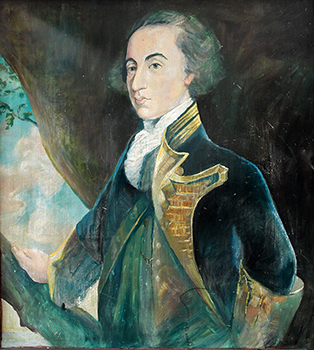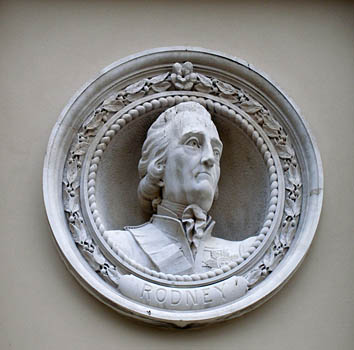 |
 |
|
| Rodney's Pillar approaching the summit of the hill | Rodney's Pillar looking North |
 |
 |
|
| Rodney's Pillar approaching the summit of the hill | Rodney's Pillar looking North |
Rodney's Pillar is set on a hilltop in Mongomeryshire about a mile from the boundary with Shropshire. It is a few miles west of Shrewsbury and to the NE of Welshpool. The ascent of this rocky outcrop on the east bank of the Severn is quite steep and involves climbing about 900 feet from where you can leave a car. However, if are fortunate to have a day like that on 7 September 2006, the views across Shropshire, Cheshire and Wales are spectacular.
There are two inscriptions by the pillar. One with faded white lettering on black marble reads records the repair of the pillar in 1983-4 with a list of the local authorities and companies that made a financial contribution. The other reads: "Erected in honour of Sir George Bryden Rodney, Admiral of the White, by subscription of the gentlemen of Montgomery 1781, repaired 1847. Renewed 1896 by subscription of gentlemen of the counties of Montgomery and Salop."
 |
 |
 |
| Admiral Rodney as depicted on a pub sign in Brewood, Staffordshire |
Plaque on the north side of the Old Royal Naval College, Greenwich, Nov 2008 |
George Rodney was baptised at St. Giles-in-the-Fields in London in February 1719. As was common at that time, he entered the navy at the age of 13 in July 1732. His first ship was HMS Sunderland but the following May he was transferred to HMS Dreadnought and in 1739 to HMS Somerset when he had his promotion from midshipman to Lieutenant. From 1741 he served on HMS Essex in the English Channel and the Mediterranean and promoted to Post Captain in November 1742. He served then on HMS Sheerness, HMS Ludlow Castle and then on the sixty-gun HMS Eagle on which he was involved in Admiral Hawke's victory at the Battle of Cape Finisterre on 14 October 1747 when six enemy ships were captured.
His next appointment (1749-52) was on HMS Rainbow where he was also Governor of Newfoundland with the task of supporting the colonists against the French in Nova Scotia. From 1752 he was based at Portsmouth for a time and was also an MP. The Seven Years War against the French (1756-63) saw him active overseas again In 1757 he was appointed to HMS Dublin and took part in the failed attack on Basque Roads in the Bay of Biscay as part of Hawke's fleet. He commanded a ship-of-the-line under Admiral Boscowen during the capture of Louisberg and Cape Breton Island. In May 1759, after the capture of Quebec, Rodney was promoted to Rear Admiral with the command of a squadron from his flagship HMS Achilles. They attacked the port of Le Havre de Grace where ships were being gathered for a possible invasion of England.
In 1761 he was re-elected to Parliament but then became Commander-in-Chief on the Leeward Islands Squadron. In February 1762 he took troops from New York under General Monckton to Martinique. The French surrendered on 16 February and St. Lucia, Grenada and St. Vincent also fell into British hands. For this he was firstly promoted to Vice Admiral in October 1762 and created a baronet in January 1764. His next appointment was as Governor of the Greenwich Hospital, a post he held for five years. In 1768 he won a parliamentary seat at Northampton but at great expense. He was promoted to the honorary position of Rear Admiral of Great Britain in 1771. He was then required to leave Greenwich and go back to the West Indies as commander in Jamaica but it was to his financial disadvantage and led him to quarrel with Lord Sandwich, the First Lord. When Rodney's appointment in Jamaica ended in 1775 he could not return at once to England because of his debts. With the help of a loan he returned to England in May 1778 by which time the American Revolution had begun.
Rodney was promoted to Admiral in 1778 and the following year became commander of the fleet at the Barbados and Leeward Islands station. He was sent first, with 20 ships-of-the-line to Gibraltar to relieve the garrison blockaded by the Spanish. First, on 8 January they encountered 22 Spanish ships including seven warships, belonging the the Caracas Company. All were captured and used to supply the garrison in Gibraltar. A few days later, on 16 January 1780, they sighted eleven Spanish ships-of-the-line off Cape St. Vincent. The battle was fought in a storm and ended in darkness at 2 o'clock in the morning but Rodney gained his most famous victory when two enemy ship were wrecked on rocks, one blew up and four were captured including enemy flagship of Admiral Langara. For this victory Rodney was appointed a Knight Commander of the Bath and was made a freeman of the City of London.
In April 1780, shortly after arrival in the West Indies, Rodney encountered a fleet of twenty two ships under the command of Comte de Guichen off Martinique but it ended indecisively. The following year, on the death of Hawke, he became Vice-Admiral of Great Britain. Rodney was eager to re-establish his finances by capturing prizes but his controversial raid on the Dutch held island of St. Eustatius gave him little gain because of legal battles. The whole episode had disatrous consequences in that Rodney was not in a position to defend Martinique, forcing Admiral Hood to Antigua. Rodney resigned and returned to England but went back to the West Indies in 1782. He won a major victory over the French at Les Saintes of Dominica on 12 April. By this time he had had the opportunity to train his fleet to a higher standard of discipline and was able to break through the French line twice. In this battle and further actions a few days later, Rodney's fleet captured seven ships-of-the line including the French flagship Ville de Paris. This victory saved Jamaica from invasion and broke French naval power in the West Indies. During the American War of Independence, Rodney was responsible for 15 of the 21 ships-of-the-line captured or destroyed and accepted the surrender of four admirals.
This victory allowed Britain a more favourable position in subsequent peace negotiations. Rodney was ennobled as Baron Rodney of Stoke-Rodney on 19 June 1782 and given a pension of £2000. From this time he retired from the navy and died ten years later on 23 May 1792, aged 73, at his home in Hanover Square in London. By his first wife, Jane Compton he had two sons and by his second wife, Henrietta Clies, had two sons and three daughters.